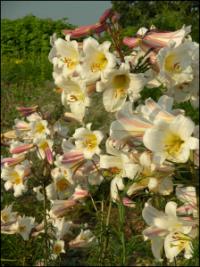Description
ARCHIVED
Note: This is a plant not currently for sale. This is an archive page preserved for informational use.
Midsummer, white trumpets flushed with purple, very fragrant
Midsummer, white trumpets flushed with purple, very fragrant
ARCHIVED
Note: This is a plant not currently for sale. This is an archive page preserved for informational use.
Midsummer, white trumpets flushed with purple, very fragrant
ARCHIVED
Note: This is a plant not currently for sale. This is an archive page preserved for informational use.
Short hedge-hog like clump with white flowers turning to bronzy spiked seedheads May-June. Best for rock, railroad or fairy gardens – anyplace for a miniature, clumping grass.
Size: 6” x 12”
Care: sun to light shade in moist soil
Native: wet places in Europe and western No. America
Collected before 1798 by Edmund Davall who botanized in Switzerland.
ARCHIVED
Note: This is a plant not currently for sale. This is an archive page preserved for informational use.
Dainty (appearing but actually tough) pink daisies with yellow centers from summer through autumn, very long blooming. Wonderful for rock gardens, groundcover or front of border.
Size: 12” x 12” spreading
Care: full sun in well-drained soil. Slow to emerge in spring.
Native: Eastern No. America
Coreopsis is Greek meaning “buglike” referring to the seeds looking like little black bugs. Thomas Nuttall 1st collected this flower in 1815 about 20 miles NW of Savannah along the river. He described its native habitat: “in open grassy swamps from New Jersey to Georgia…” William Robinson, father of the mixed perennial border called this “a neat and pretty plant.” In 1913 Sanders wrote that it “make(s) a brilliant display of color (when) grown in masses in sunny borders.”
ARCHIVED
Note: This is a plant not currently for sale. This is an archive page preserved for informational use.
Small gentian flowers with golden eyes, spring into fall.
Can not ship to: New Hampshire
Size: 9-12” x 12”
Care: sun to part shade in moist soil
Native: temperate areas world wide
“Myosotis” is Greek meaning mouse ear for the leaf shape. Around 1390 Henry IV adopted soveigne vous de moy, Forget-me-not, as a symbol not to forget his reign. A German legend attributes the common name to a lover who, gathering the flower, cried out “forget-me-not” as he fell into the river and died. Alfred Lord Tennyson wrote: “The sweet forget-me-nots; That grow for happy lovers.” Persian poet Shiraz told another folk tale: an angel fell from heaven by falling in love with a “daughter of earth,”when they sat by a river twining Forget-me-not flowers in her hair. The angel was not allowed to return until the lovers planted Forget-me-nots in every corner of the earth, which they did, hand in hand. She then became immortal “without tasting the bitterness of death” and joined the angel in Paradise.
ARCHIVED
Note: This is a plant not currently for sale. This is an archive page preserved for informational use.
Covered with petite double white daisies with golden stamens blooming for months –late summer-fall.
Size: 2-3’ x 1-2’
Care: sun to part shade in well-drained to moist well-drained soil
Native: Japan
Awards: Georgia Gold Medal 1998
Taxonomists had trouble naming this one. First described in French Journal Nouv. Arch. Mus. Hist. Nat. in 1882. A favorite flower of the late garden writer Elizabeth Lawrence who traced it to the grounds of the old Oxford Orphanage in Oxford NC. (1942)

